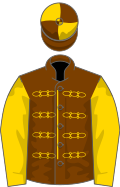| Class | Group 2 |
|---|---|
| Location | Ascot Racecourse Ascot, England |
| Inaugurated | 1834 |
| Race type | Flat / Thoroughbred |
| Website | Ascot |
| Race information | |
| Distance | 1m 3f 211y (2,406 metres) |
| Surface | Turf |
| Track | Right-handed |
| Qualification | Three-year-old colts and geldings |
| Weight | 9 st 0 lb Penalties 3 lb for G1 winners * * since 31 August 2017 |
| Purse | £250,500 (2022) 1st: £142,059 |
| 2025 | ||
 |  |  |
| Amiloc | Zahrann | Galveston |
| Previous years | ||
|---|---|---|
| 2024 | ||
 |  |  |
| Calandagan | Space Legend | Royal Supremacy |
| 2023 | ||
 |  |  |
| King Of Steel | Continuous | Artistic Star |
| 2022 | ||
 |  |  |
| Changingoftheguard | Grand Alliance | Lysander |
| 2021 | ||
 |  |  |
| Alenquer | Tasman Bay | Title |
| 1990-1988 | ||
|---|---|---|
| 1990 | ||
 |  |  |
| Private Tender | Mukddaam | Air Music |
| 1989 | ||
 |  |  |
| Cacoethes | Zayyani | Spring Hay |
| 1988 | ||
 |  |  |
| Sheriff's Star | Polar Gap | Kalakate |
The King Edward VII Stakes is a Group 2 flat horse race in Great Britain open to three-year-old colts and geldings. It is run at Ascot over a distance of 1 mile 3 furlongs and 211 yards (2,406 metres), and it is scheduled to take place each year in June.
Contents
The event was established in 1834, and it was originally known as the Ascot Derby. In the early part of its history it was also open to fillies. The race was renamed in memory of King Edward VII in 1926.
The King Edward VII Stakes is currently held about two weeks after The Derby, and it usually features horses which were entered for that race. It is contested on the fourth day of the five-day Royal Ascot meeting.













































